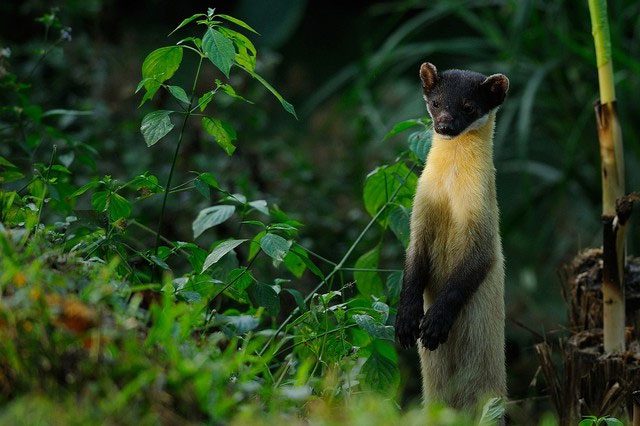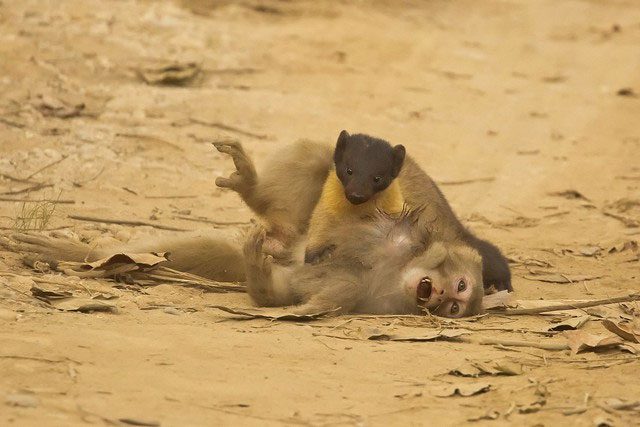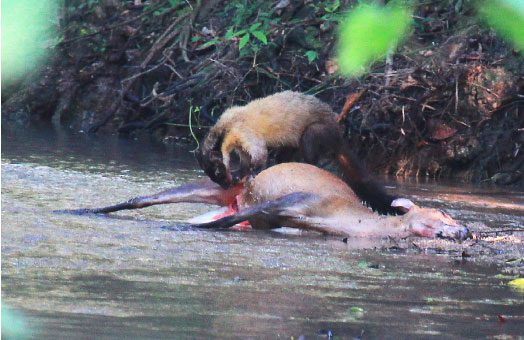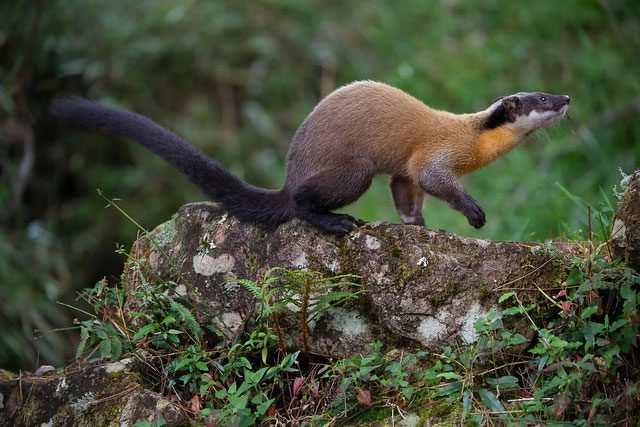When it comes to wild animals, we often think of large carnivores like tigers, lions, and bears. However, in this dense forest, there is a “little beast” that weighs only about 2 – 3.5 kg but impresses everyone with its extraordinary courage and hunting skills. They are the yellow-throated marten (Martes flavigula).
Not long ago, shocking news stirred the biology research community: four yellow-throated martens successfully hunted a wild boar weighing 250 kg! This news not only shocked but also sparked strong interest in the yellow-throated marten species. What strength allowed these four small martens to defeat such a large opponent?

The yellow-throated marten (Martes flavigula), also known as the golden-bellied marten, is a small carnivorous mammal that possesses extraordinary hunting abilities. Although its size is similar to that of a domestic cat, it is a formidable predator to many animals much larger than itself.
To answer this question, we first need to understand the basic habits of the yellow-throated marten. The yellow-throated marten is a small carnivore belonging to the Mustelidae family, mainly living in low-altitude pine forests and high-altitude coniferous forests. They typically weigh between 2-3.5 kg and have a body length of about 56-65 cm. Despite their small size, yellow-throated martens have sharp claws and teeth as well as agility.
Regarding hunting, yellow-throated martens employ methods such as stealthy attacks from behind and choking. They use their flexible bodies and keen senses to attack prey from behind, then leap up and grasp the prey’s throat with their sharp claws and teeth. This way, yellow-throated martens can quickly subdue their prey, rendering it incapable of resistance.

Yellow-throated martens often hunt alone, using agility, flexibility, and keen hearing to stalk and attack prey. When faced with larger or fiercer prey, yellow-throated martens can work together in packs. They coordinate seamlessly to restrain the prey, creating opportunities for other individuals to attack vulnerable points.
So how did four yellow-throated martens manage to hunt a 250 kg wild boar?
This incident occurred in a dense forest. At that time, the four yellow-throated martens were foraging for food. Suddenly, they spotted a wild boar rummaging for food. This wild boar was enormous, weighing up to 250 kg and appearing very fierce. However, this did not intimidate the four yellow-throated martens; instead, they quickly devised a hunting plan and acted.
First, two yellow-throated martens attracted the wild boar’s attention from the front, while the other two quietly circled around to the back. When the wild boar was distracted by the two martens in front, the two martens at the back swiftly attacked. They jumped up and locked onto the wild boar’s throat with their sharp claws and teeth. The wild boar suddenly panicked and tried to escape, but it was too late. With the combined efforts of the four yellow-throated martens, the wild boar was quickly subdued and killed.
This event not only showcases the exceptional hunting skills of the yellow-throated marten but also reveals their courageous spirit and unity. Faced with the massive wild boar, the four yellow-throated martens did not choose to retreat or escape but bravely launched their attack.

Thanks to their sharp claws and agile bodies, yellow-throated martens can easily climb high trees to pursue prey or search for food. Their swimming ability is also impressive, allowing them to catch fish and other animals living near water.
In fact, the aggression of yellow-throated martens is not a coincidence. In the wild, they are highly competitive creatures. To survive and reproduce, they must continuously hunt and forage. Through this process, yellow-throated martens gradually develop unique hunting skills and survival strategies. They are excellent observers and can quickly detect weaknesses in their prey while formulating effective hunting plans.
Additionally, yellow-throated martens are also very intelligent animals. They can continuously improve their hunting skills through learning and practice. Studies have shown that yellow-throated martens use various strategies during hunting, such as stealth attacks from behind, choking, and division of labor. Utilizing these strategies not only enhances their hunting success rate but also helps them secure an important position in nature.

Yellow-throated martens primarily hunt small animals such as mice, squirrels, rabbits, birds, reptiles, and insects. Not only do they target small prey, but yellow-throated martens can also take down prey much larger than themselves, such as wild chickens, mountain goats, and even giant pandas or wild boars.
However, despite their powerful hunting abilities and competitive survival skills, the survival situation of yellow-throated martens is not optimistic. Their numbers are declining due to excessive hunting by humans and habitat destruction. Currently, yellow-throated martens in China have been classified as a nationally protected animal at level 2 and are in urgent need of public attention and protection.

Despite their small size, yellow-throated martens possess a strong bite force relative to their body size. This biting power helps them easily subdue prey while crushing bones and tendons.
In conclusion, the incident of four yellow-throated martens hunting a 250 kg wild boar reminds us once again that this species, though small, is filled with courage and intelligence. With their extraordinary bravery and hunting skills, they have carved out a niche in nature and become subjects of research and admiration from humans. At the same time, we should also pay attention to the survival status of the yellow-throated marten and take proactive measures to protect this precious species from extinction.


















































